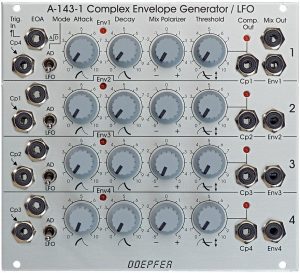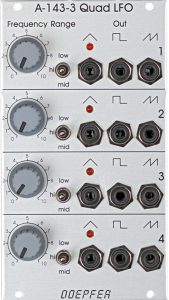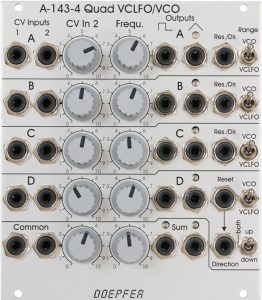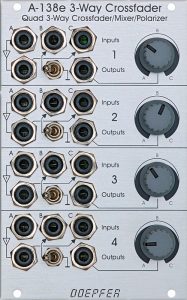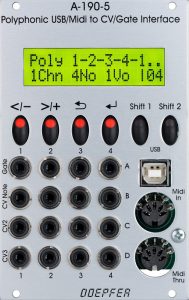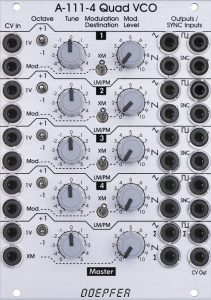When I wrote “The Big Book on the A-100” in 2011 (German ony), it still said:
Modular analog synthesizers are usually monophonic.
Das große Buch zum Doepfer A-100, p.18, Ideenhase Verlag, 2011
… and added a little later by:
Unless you spend a lot of money, but even then the polyphony remains quite awkward to use.
A-100 analog modular Website, November 2017
At that time there were hardly any polyphonic midi-CV interfaces and hardly any modules with common controls for several oscillators, filters, envelopes, etc. If you wanted modular polyphony, that was expensive – after all, every single voice needs all the modules like VCO, VCF, VCA, ADSR, etc.
In addition, the voices of a poly-modular had to be manually adjusted to each other. Rapid changes in sound – one of the main attractions of a modular system – were hardly feasible with it.
That has changed.
The beginnings: multi-modules
There were only a handful of multi-modules “in the ancient days”, mainly in the A-143 series: The A-143-1 Quad Attack-Decay envelope generator, A-143-2 Quad ADSR, A-143-3 Quad LFO and later the A-143-4 Quad VCLFO/VCO or the super-flexible A-138e Quad Crossfader and the A-142-4 Quad Decay Generator. These were and are extremely solid and, compared to individual modules, very cheap solutions, but only the A-143-4 had a common control for its four LFOs/VCOs. With the other modules, the four sub-modules still had to be matched to one another separately by hand.
These modules were practical and inexpensive solutions for accommodating frequently used functions such as LFOs or envelopes multiple times in the rack. By the standards of the time, they were also space-saving – current “Slim Line” modules are of course a lot more compact. And yes: if you wanted, you could move towards polyphony, but that wasn’t really the main purpose of the modules.
What makes polyphony so complex?
In principle, you can of course patch several synthesizer voices with multiple available VCOs, VCFs, VCAs and envelope generators with any somewhat more extensive system. If the individual oscillators, filters, etc. are identical in construction, then all four voices will even sound somewhat similar. You can still manage that, and if you don’t have that many modules, you can simply record the sounds of a single “voice” and feed it to your sampler.
The difficulties arise when it comes to changing all voices in the same way, e.g. opening all filters together while playing. With a monophonic synthesizer voice, I simply turn the filter cutoff knob. With four voices, I’m missing at least 3 hands. It looks similar if I want to increase the attack time of the envelopes for all voices, or the vibrato intensity for all oscillators.
The solution to this lies in the original design principle of modular synthesizers: voltage control and VCAs!
A parameter is changed on several modules at the same time
Let’s start with a very simple example. In order to control the cutoff-frequency of four filters simultaneously, you need a voltage source (e.g. an analog modulation wheel with CV output), a multiple and the existing CV inputs of the filters. Now the filters first have to be adjusted manually (cutoff frequency, resonance, modulation intensity, same wiring, etc.), then I can control the cutoff frequencies for all four filters together using the modulation wheel. That’s still trivial.
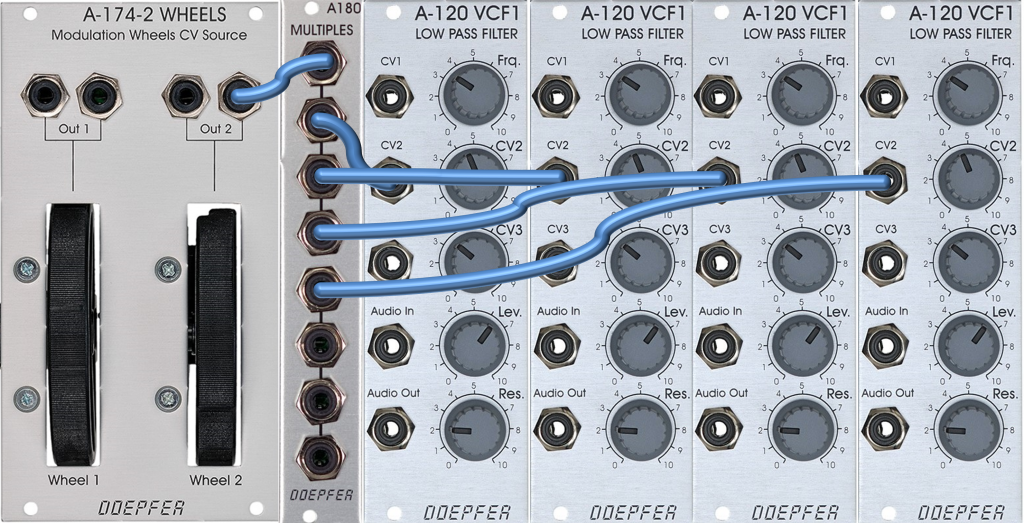
Changing the modulation intensity for several modules at the same time
Very often, however, it is not a question of simple manual control, but of joint regulation of the modulation intensity. For example, if I want to fade in and fade out vibrato on all four VCOs at the same time, then I need one VCA for that. My CV source can again be the mod wheel connected to the control voltage input of the VCA. The VCA amplifies an LFO and feeds the CV input of the oscillators via a multiple. Besides the multiple, this is no different than you would do with a monophonic synthesizer. Elementary, dear Watson.
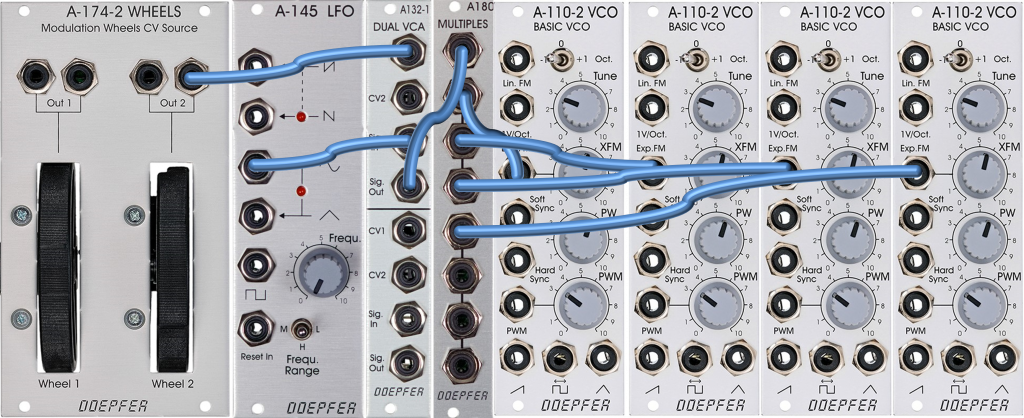
Each module has its own modulation source
It becomes even more complex if several (slightly) different modulation sources are to be controlled. If instead of a single LFO we want to control four non-synchronous LFOs or e.g. the modulation intensity of four envelopes on the four filters, then we already need four VCAs: The control voltage for all VCAs comes from the mod wheel again and the four ADSR control voltages are amplified separately – but in the same way.

Problems with the previous approach
At least here you can see:
- The space requirement increases! With conventional modules, we need space for multiples and amplifiers in addition to the multiple module equipment (not even fully shown here).
- Due to the extensive wiring, the patch is slowly becoming confusing, the arrangement of the sockets next to the rotary controls does not make the cable clutter any easier.
- We also need additional dedicated controls (here the modwheels) for trivial functions like the filter cutoff frequency.
This is complex, expensive (also in terms of the required rack space) and difficult to use in practice. In addition, not all functions can be controlled externally via VCAs and control voltages on all modules. The following table shows this based on the resonance of filters:
| Filters: | Ability to externally control the resonance: |
|---|---|
| A-101-1 | CV inputs “CVQ In 1” and “CVQ In 2” |
| A-101-2 | no |
| A-101-3 | via external VCAs and the “Feedback-In” inputs |
| A-101-6 | via external VCA and the input “FB In” |
| A-102 | no |
| A-103 | no |
| A-104 | no |
| A-105 | CV input “QCV” |
| A-106-1 | via external VCA and the input “Res. Insert” |
| A-106-5 | no |
| A-106-6 | CV input “QCV” |
| A-107 | CV inputs “Res.CV1” and “Res.CV2” |
| A-108 | via external VCA and the input “Feedb.” |
| A-109 | CV inputs “CVQ1” and “CVQ2” |
| A-111-5 | no |
| A-111-6 | no |
| A-120 | no |
| A-121 | CV inputs “QCV1” and “QCV2” |
| A-121s | CV inputs “QM/TM1” and “QM/TM2” |
| A-121-2 | CV input “FCQ” |
| A-121-3 | CV input “CQ” |
| A-122 | CV input “QCV” |
| A-123 | CV input “QCV” |
| A-123-2 | CV input “QCV” |
| A-124 | no |
| A-125 | no |
| A-127 | no |
New modules with integrated poly functionality
- A-132-8 Octal Poly VCA
- A-111-4 Quad Precision VCO
- A-105-4 Quad Poly SSI VCF
- A-141-4 Quad Poly VCADSR
- A-149-4 Quad Random Voltage Source
- A-171-4 Quad VC Slew Limiter
- A-190-5 Polyphonic USB/Midi-to-CV/Gate Interface
- A-135-5 Polyphonic Mixer
From 2018, Doepfer introduced their first polyphonic modules. First a quadruple VCO, then – each designed for four voices – filter, VCA, ADSR and Midi interface. The new Poly modules solve many of the previous problems:
- The quadruple polyphonic modules for filter, ADSR and VCA are each only 8 HP wide, which corresponds to a single A-105-1, A-140 or A-132-3, for example.
- With the exception of the A-111-4 VCO, the patch sockets are all located below the controls, which provides a much better overview.
- Many frequently used connections between the modules can be established directly on the circuit boards as default connections, but can be replaced by patch cables on the front panels (switch sockets) if required.
- The functions of a module (e.g. cutoff-frequency or resonance of all four filters) can be controlled for all “voices” directly via controls on the front panels and additionally via control voltages.
- Parameters that can only be set manually in many conventional modules (resonance, ADSR values, etc.) can also be influenced via control voltages.

This means that there is an almost complete set of poly modules, starting with the polyphonic A-190-5 midi interface, the quadruple VCO A-111-4, the quadruple SSM filter A-105-4, the four-voice double VCA A-132-8 (with cascaded linear and exponential VCAs) and the polyphonic A-141-4 VCADSR. A new addition (mid-2023) is the polyphonic slew limiter A-171-4.
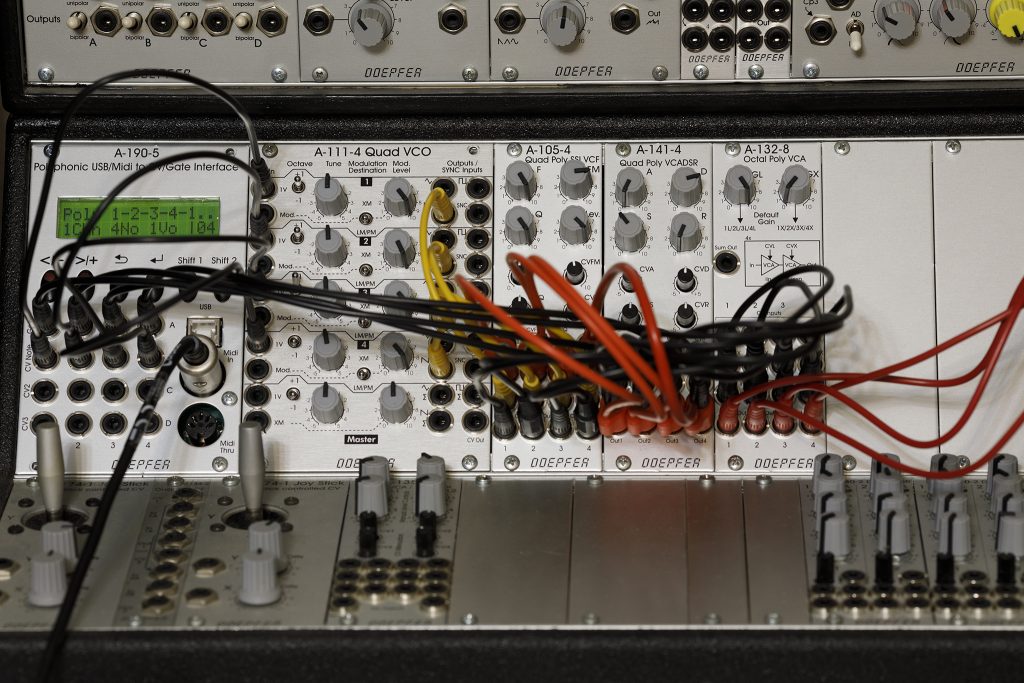
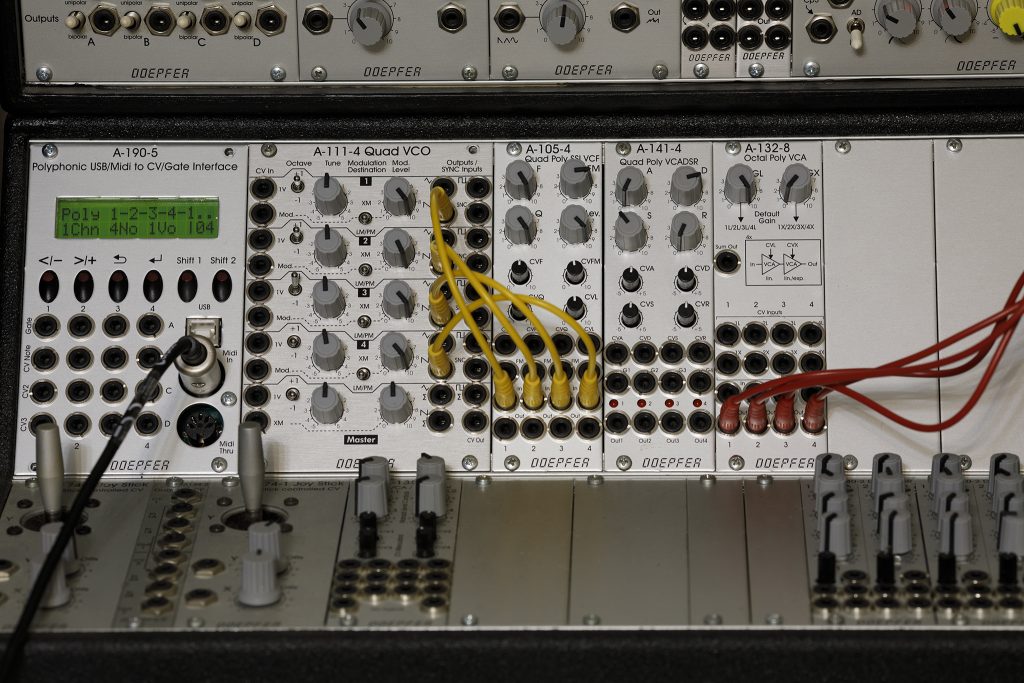
What is still missing? What goes with it?
Polyphonic mixer
You can go a long way with the special poly modules mentioned above. The biggest current (December 2022) gap is probably a polyphonic mixer for the audio signals if you want to use a second A-111-4 and/or e.g. noise as a sound source. Many use the A-138n Narrow Mixers, which then have to be set manually for each voice. If necessary, two A-135-3 VC stereo mixers can also be modified so that both mixers work together.
The situation is similar if you want to use several (polyphonic) control voltage sources. For example, if the filters are to be modulated by (a) envelopes, (b) velocity per note played from the A-190-5 and (c) four LFOs, e.g. from the small A-145-4. For this I use two A-130-8 Octal VCAs and the new A-183-5 Quad Attenuator: There is a common mix output (Sum Out 1-4 and 5-8) for any four of the VCAs in the A-130-8, so we can mix the control voltages for any of the four filters in the A-105-4. Now you only need a quadruple voltage source for the levels of the envelope, velocity, LFO (and maybe another modulation source), which is distributed to the four “mixers” of the two A-130-8 via multiples or stackables. This is done by the quadruple attenuator A-183-5, which has to be supplied with a constant voltage source of 5V at its 4 inputs (or is internally modified accordingly).
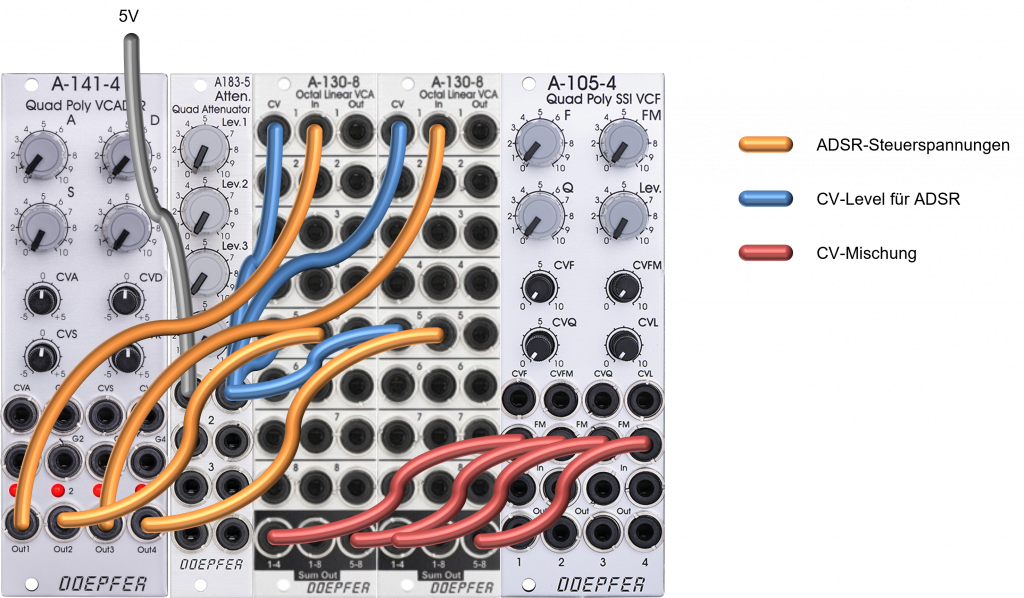
Of course, the A-130-8 can also be used to mix the VCOs.
The venerable A-138m Matrix Mixer or the new A-138j Inverting/Interrupting Mixer can also provide valuable services for control voltages. This A-138j “Janus Mixer” is particularly interesting in combination with the A-141-4, because it can be used not only as a mixer, but also as a quadruple inverter and attenuator (e.g. inverted envelopes for filter modulation).
If you want to work DAW-less, the A-138s Mini Stereo Mixer, the A-138o/p Performance Mixer or – very luxuriously – the A-135-4 VC Performance Mixer are interesting options for mixing the four complete voices in the stereo image.
If you want it to be very minimalistic (and save space as well as costs), you can use two A-138f dual crossfaders. This allows two out of three input signals to be crossfaded (A&B or B&C from the “12 o’clock” position of the purely manual fader).
Update May 2023: Doepfer has now announced the A-135-5 Polyphonic Mixer. There are three inputs for each of the four voices (e.g. for three A-111-4 VCOs), one of the three quadruple inputs is connected by default to an internal frequency divider that can work as a "sub-oscillator" for the first input. Very exciting and a long-awaited addition to the poly system!
Random poly sequences
The A-149-4 Quad Random Voltage Source module is relatively new: controlled via four trigger inputs, it can generate four random, but if necessary quantized, control voltages in order to produce polyphonic random sequences. The quantization is very similar to the capabilities of the A-156 Quantizer: octaves, fifths, chords and scales in major and minor, additional sixths and sevenths, etc. – just four of them! A random generation of triggers, as enabled by the A-149-2 module with up to 8 independent triggers, fits in with this.
Switches
With 4 voices, it’s often handy to be able to quickly switch between different audio or modulation sources instead of replugging a handful of patch cords while playing. This is where the A-182-2 Quad Switch, the A-182-4 Rotary Switch, the A-138f Dual Three-Way Crossfader (or its luxurious but sadly discontinued predecessor, the A-138e) come into consideration.
If you want to switch automatically, the A-150-8 Octal manual/CV/programmable switch can be used in a polyphonic context. The module can be programmed in such a way that it can also switch several patch cords at the same time.
Portamento
In mid-2023, Doepfer presented the small poly portamento module A-171-4. The structure is very clear: four inputs and four outputs each, a control voltage input, a manual regulator and an attenuator for the control voltage. Since the module is built on purely analogue (vactrol) control circuits, the portamentos are also very “organic” and not mathematically exact, such as with a digital solution.
Modulation sources
The already mentioned multiple modules A-142-4 Quad Decay, A-143-1 Quad AD, A-143-2 Quad ADSR, A-143-3 Quad LFO and its “Slim-Line” descendant A-145- 4, as well as the A-143-4 Quad VCLFO/VCO are always worthwhile additions to a polyphonic setup, because the completely manual settings bring lively variations to the modulation process.
The A-143-9 VC Quadrature LFO is also exciting with its 4 synchronous but phase-shifted sine waves, e.g. for pulse width modulation or subtle modulation of the VCO frequencies. A very low LFO frequency and only minimal modulation on the VCOs can recreate the drift of old synths, or replace a “detune” function in the unisono mode of the A-190-5 (there is a sound example of this in the post on the A-111-4).
Manual CV and gate sources have unfortunately been thinned out a bit at Doepfer lately (the old A-174-1 joystick, the A-144 Morphing Controller, A-176 Manual CV Source and A-164 Manual Gate are no longer manufactured). You can use the new A-174-4 Joystick, the A-177-2 Foot Controller, the A-174-2 Wheels or the A-173-1/2 Micro Keyboard for this.
Envelopes
Yes, the polyphonic A-141-4 is a fantastic piece of hardware, it can also be pre-wired via the board with the A-190-5 as a gate source, the A-105-4 and the A-132-4 as a CV receiver.
If you don’t have one, you can use the A-140-2 Dual Mini ADSRs with a little more “cable clutter”. The parameters of the envelopes have to be adjusted manually here, but the duration of the attack, decay and release times per envelope can be controlled via a control voltage (e.g. by the velocity per note from the A-190-5). The second output per ADSR on the A-140-2 is useful if you want to modulate VCA and VCF at the same time, if necessary with an inverted envelope on the second output.
Who neither owns the polyphonic A-141-4 ADSR nor the polyphonic A-132-8 VCA, or use them in a patch for other purposes, can use after an A-111-4 and an A-105-4 the A-142-2 Dual Envelope Controlled VCAs: Manual presetting is also required here, but the times of the envelopes, which are kept very simple, can then be adjusted via external control voltages.
Open wishes
Of course I would like to have one or two additional poly modules. But this is just my very personal point of view, every user certainly has their own preferences and ideas.
- I have already mentioned the polyphonic mixer, for mixing several A-111-4 VCOs or noise, but also for mixing several (polyphonic) modulation sources.
- Or a polyphonic sub-oscillator. If you want to take the idea to the extreme, then it would be designed like the A-113 (Trautonium) Subharmonic Generator and doesn’t generate trivial square wavess, but something similar to sawtooth oscillations and can handle not only octaves but also other harmonic dividers.
- More polyphonic filters, of course, but there will probably be “partial opinions” among the users. A good complement to the very rich sounding A-105-4 24dB lowpass would be a polyphonic 12dB multimode filter like the always “nice-sounding” A-106-5 SEM or the cheekier A-124 Wasp-Filer. Two A-121s stereo multimode filters represent a completely useful and very good-sounding compromise: The basic setting must be made manually on both modules, but you can then regulate practically everything via control voltages (cutoff-frequency, resonance, filter type) via a variety of modulation inputs. In the module description for the A-121s there is also a four-part polyphonic sound example.
- A polyphonic waveshaper would be exciting, as you can see with the Arturia Polybrute, for example.
Update May 2023: With the A-135-5 Polyphonic Mixer, Doepfer has announced a mixer for polyphonic sound sources, which also has a built-in suboscillator!
Polyphony with mini synthesizer modules – an alternative?
With four A-111-6 mini synthesizer modules, a polyphonic system can be put together, which, with a space requirement of 40TE, is even slightly narrower than the combination A-111-4, A-105-4, A-132-8 and A-141-4 (42TE). Because the sockets of the “Slim Line” Mini are arranged below and because no cables are required between the VCO, VCF, VCA and envelope generator, even the wiring remains fairly clear. Compared to the polyphonic modules mentioned above, you save about 200 euros.
Pulse and sawtooth or pulse and triangle can already be mixed “on board” with the A-111-6. There is even a mixable sub-oscillator that can be replaced with an A-111-4 via the “Ext. In” sockets, for example, so that a 2-VCO polysynth is possible without an additional mixer.
If you have more space and budget available, the A-111-6 synthesizer can also be supplemented with four A-111-3 Micro Precision VCOs. Tracking and quality are on a par with the A-111-4, but there are significantly more modulation options that can be accessed directly, for which you would first have to move jumpers on the circuit board of the A-111-4, for example. In the post to the A-111-3 there are some sound examples in polyphonic use.
For joint “remote control” of the filter cutoff frequency, the envelope curve times and the balance of the VCO and suboscillator (or external signal) the sockets “VCF FM2”, “CVT” and “CV Bal.” can be used. The older A-111-5 Incidentally, the mini synthesizer does not offer any of these three options and is in a different “league” in terms of price and space requirements (24 HP), which makes it less attractive for polyphonic applications than the A-111-6.
However, there are a number of limitations of the A-111-6 mini synthesizer compared to the polyphonic modules:
- There is no direct possibility of internal pre-wiring of VCA-CV and envelope gates with the A-190-5 interface.
- The basic settings must be adjusted manually for each voice.
- An external control of the modulation depth of the filter FM or the filter resonance is not possible.
- Compared to the A-141-4, the envelope generator is quite simply equipped with its two controls (attack and decay/release).
All in all, the A-111-6 is a budget alternative for polyphonic applications, which shines with an attractive sub-oscillator and low cabling requirements, as long as you accept the trouble of manually pre-setting all four voices and the functional limitations.
Update: In the sound examples for the A-111-6 you will of course also find four modules in polyphonic use.
Posts on poly and multiple modules
Posts on polyphonic modules
- A-105-4 Quad Poly SSI VCF
- A-111-4 Quad Precision VCO
- A-132-8 Octal Poly VCA
- A-135-5 Polyphonic Mixer
- A-141-4 Quad Poly VCADSR
- A-149-4 Quad Random Voltage Source
- A-171-4 Quad VC Slew Limiter
- A-190-5 Polyphonic USB/Midi-to-CV/Gate Interface
Posts on quadruple or eightfold modules
- A-130-8 Octal Linear VCA
- A-143-1 Complex Envelope Generator / LFO
- A-143-4 Quad VCLFO/VCO
- A-149-4 Quad Random Voltage Source
- A-150-8 Octal Manual/Voltage Controlled Programmable Switches
- A-152 Voltage Addressed Track&Hold / Switch
- A-183-5 Quad Attenuator
Previous chapter:
